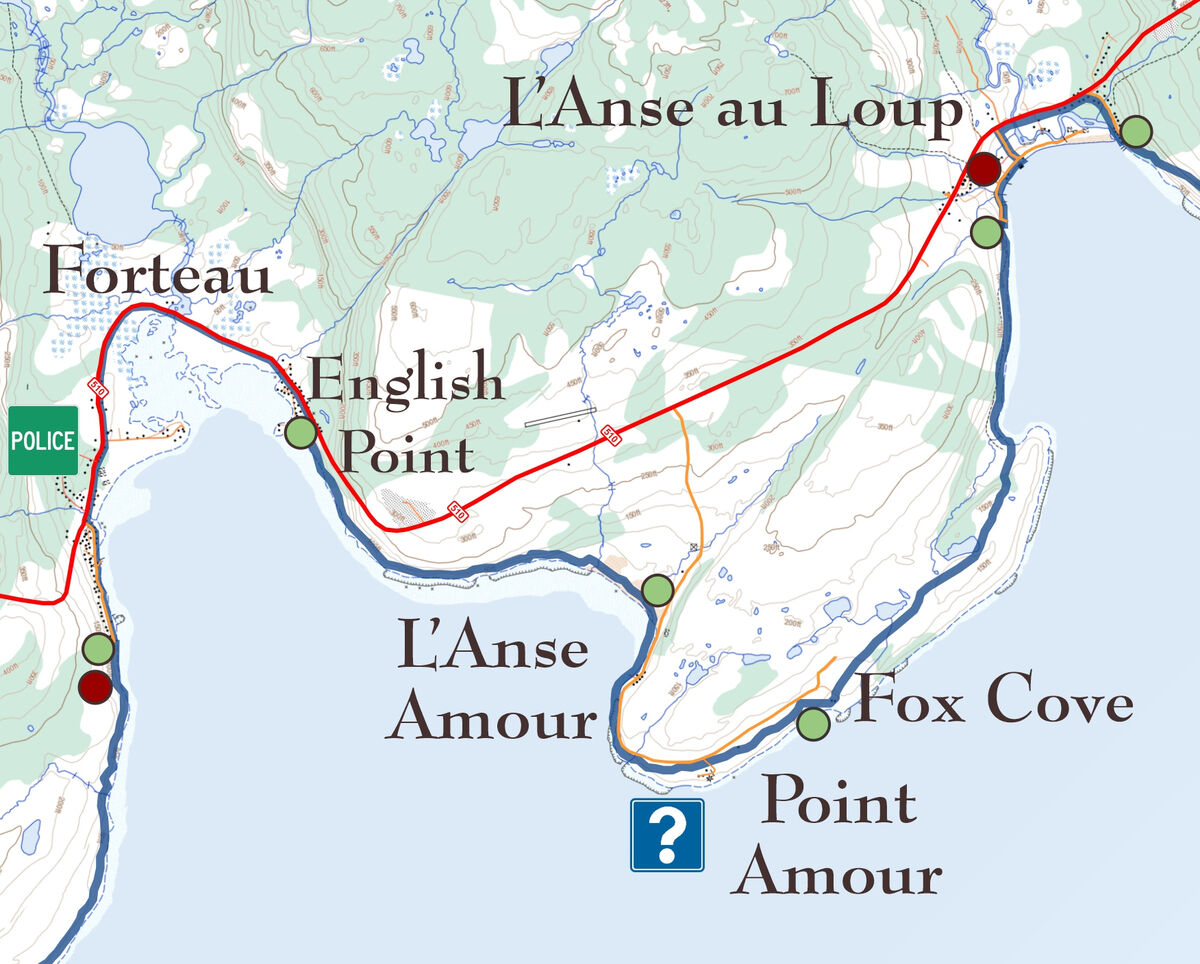Forteau to L'Anse au Loup
Arrive at Forteau
From L'Anse au Clair you arrive on the western shore of Forteau Bay. From here you may walk the road through town until you reach English Point. At the English Point Trail Head you may rejoin the trail for the hike onwards to L'Anse au Loup.

The Town of Forteau
Forteau includes the small communities of English Point and Buckles Point. Its name is derived from the French words meaning "Strong Waters". A Jersey merchant, De Quettville, started a fishing business here in 1774, and in 1818, it was reported that Forteau was the largest British establishment in the Straits. Guernseymen settled in Forteau on the western side of the bay at Buckle's Point, while a group from Devonshire, England settled at English Point on the eastern side of the bay. When Bishop Feild of the Anglican Church was appointed to Newfoundland in 1845, he was surprised to learn that Labrador was within his jurisdiction. He visited Forteau in 1848 and in 1849 the first church was built there.
English Point to Point Amour
The trail from English Point leads you around Crow Head, the steep headland of Forteau Bay. Once past the headland the cove of L'Anse Amour opens before you. The cove is ringed by sandy beaches and is home to a tiny community with a unique history tied to nearby Point Amour Lighthouse.
A Walkers Perspective: English Point to Point Amour
Leaving English Point it's a 6Km hike to L'anse Amour. The trail is covered with gravel for the first 500m then it enters a wooded area and on to an aggregate lay down area for another 600m. The trail is well marked in this area. After leaving the area, the trail gets much narrower rocky. You have to be careful stepping over the rocks that may cause you to fall. Some places you are close to the edge of the embankment. We get a good view of the town of Forteau across the bay and to the East L'anse Amour; and towering Crow Head cliff all the way to the most difficult section.
Getting to the beach at about 4Km, require you to step down an embankment onto shifty rolling rocks. Just be careful when stepping on those rocks: they continue for some 200m. The area may be impassable during high tides and windy conditions. After this difficult section of the trail we reach a grassy area that continues on to great sandy beach. There are several bridged brook crossings, but walking in sand makes the hike more difficult. You continue to the highway and on through the community of L'anse Amour, to the Raleigh site and eventually the Point Amour lighthouse.
This trail has easy, moderate and hard sections.
L'Anse Amour
Translated as "Cove of Love", the name is actually a romanticized version of "Anse aux Morts" (Cove of the Dead), probably named because of the many lives lost in dramatic shipwrecks nearby. L'Anse Amour is the site of the earliest known funeral monument in North America, a 7,500 year-old Maritime Archaic burial. The Davis family has lived in L'Anse Amour for the past one hundred and fifty years. In 1922, the land was granted to the family by King George V for their role in rescuing the sailors from the British navy ship, HMS Raleigh. This British light cruiser went ashore near Point Amour on August 8, 1922 while enroute to Forteau Bay.
Wreck of the Raleigh at L'Anse Amour
They were goin' to the river. To go trouting, you know, all of those officers. Oh, it was black thick fog. And then when she went ashore, the Captain called for volunteers and there was eleven stokers. The only thing they done was shovel coal as far as I'm concerned. 'Fer, knowing anything about the water or anything like that, they … knew nothing and they got in the life boat to come ashore. They didn't know where they were coming, 'twas black thick with fog, they couldn't even see the land. Well they got drowned when she struck the land. When their life boats come in from the Raleigh, she came in and struck the shoal and went bottom up. That's how they got drowned.
Wilfred Davis, The Raleigh, Coastal Heritage Collection
Point Amour Lighthouse
At 109 feet from the ground to the light itself, Point Amour lighthouse is the tallest in Atlantic Canada and the second tallest lighthouse ever built in Canada. It is still a working lighthouse. The light tower is 24 feet 6 inches in diameter at ground level, tapering to 8 feet 9 inches at the cornice. The walls at the base are about 6 feet thick with foundations carried down to solid rock. Also constructed of limestone, the two-storey keeper's house is 50 feet in length and 24 feet 6 inches in width.
The lighthouse tower and surrounding buildings have been designated a Provincial Historic Site. The residential part of the lighthouse, now renovated and partially restored to the 1850s period, houses an extensive series of exhibits portraying the evolution of lighthouse technology and the maritime history of the Labrador Straits.
Fossil Reefs at Point Amour
Point Amour lighthouse is built on a fossil reef. The rocks around the lighthouse include pink and red sandstone, red to purple mudstone, and medium to thin-bedded grey and orange-weathering limestone. The purple mudstone contains rings and irregular fragments of white calcite. These are the remains of now-extinct, primitive organisms called archeocyathids, which once formed reefs similar to modern coral reefs. These reefs are known only in a few places world-wide.
Point Amour to L'Anse au Loup
A Walker's Perspective: Point Amour to L'Anse au Loup
Text to come...





